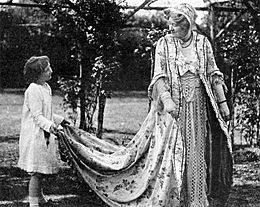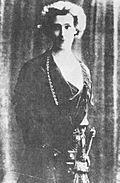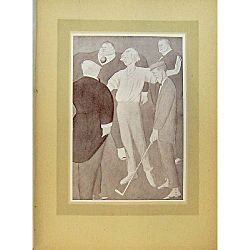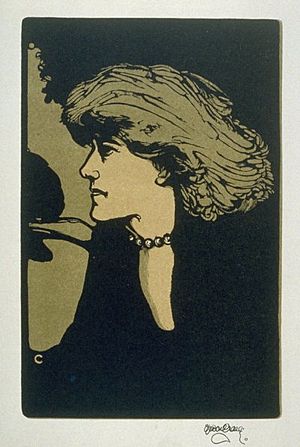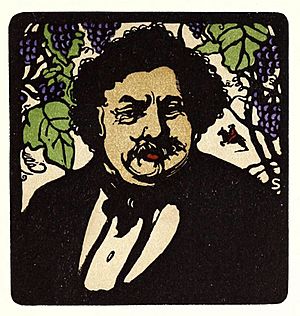Edward Gordon Craig facts for kids
Quick facts for kids
Edward Gordon Craig
|
|
|---|---|
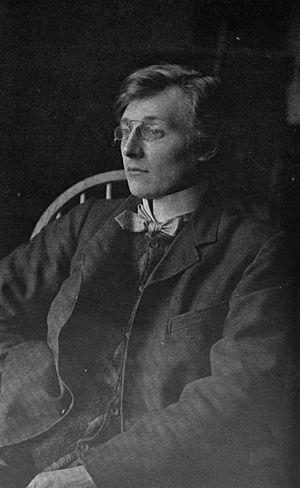 |
|
| Born | Edward Godwin 16 January 1872 Stevenage, Hertfordshire, England |
| Died | 29 July 1966 (aged 94) Vence, France |
| Occupation | Stage designer, theatre director, theatre theorist, actor |
| Period | Modernism |
| Literary movement | Symbolism |
| Notable works | On The Art of the Theatre (1911) The Mask (1908–1929) MAT production of Hamlet (1911–1912) |
| Spouse |
Helen Mary Gibson
(m. 1893; div. 1932) |
| Partner | Elena Meo Isadora Duncan |
| Children | 9 |
Edward Henry Gordon Craig (born Edward Godwin; 16 January 1872 – 29 July 1966) was an English theatre artist. He was an actor, director, and stage designer. He also wrote many important ideas about theatre. Craig was the son of the famous actress Ellen Terry.
A theatre in Stevenage, where he was born, was named the Gordon Craig Theatre in his honor in 1975.
Contents
Life and Family
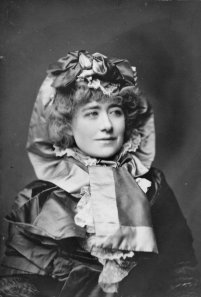
Edward Gordon Craig was born Edward Godwin on 16 January 1872 in Stevenage, England. His parents were architect Edward William Godwin and actress Ellen Terry. He later changed his last name to Craig when he was 21 years old.
Craig spent a lot of his childhood at the Lyceum Theatre, London. His mother, Ellen Terry, was the main actress there, working with Henry Irving. Craig later wrote a book praising Irving. Craig also had a sister named Edith Craig.
In 1893, Craig married Helen Mary Gibson. They had five children together: Philip, Rosemary, Henry, John, and Peter. He also had other children, including Nell and Edward with Elena Meo, and Deirdre with dancer Isadora Duncan.
Craig lived in France for many years. He passed away in Vence, France, in 1966, when he was 94 years old.
Career in Theatre
Craig believed that the director was the most important artist in the theatre. He even suggested that actors were like marionettes (puppets) in a way, meaning they should follow the director's vision closely. He designed detailed and symbolic sets. For example, he created movable screens for the famous Hamlet production in Moscow. He was also the main writer and editor for The Mask, which was the first international theatre magazine.
Craig started his career as an actor with Henry Irving's theatre company. But he became more interested in art and design. He learned to carve wood. He stopped acting in 1897 to focus on theatrical design.
Early Productions
Craig's first plays he directed were Dido and Aeneas by Henry Purcell and Acis and Galatea by George Friedrich Handel. These were produced in London. His production of Dido and Aeneas was very successful. It helped bring back interest in Purcell's music. Craig liked to keep his designs simple. This helped to highlight the actors' movements and the lighting. He also introduced the idea of a "unified stage picture." This meant all parts of the design worked together.
Moving Abroad and Key Works
After not finding much financial success in Britain, Craig moved to Germany in 1904. While there, he wrote one of his most famous books, The Art of the Theatre. In 1908, he met Konstantin Stanislavski, who founded the Moscow Art Theatre. Stanislavski invited Craig to direct their famous production of Hamlet, which opened in 1911.
Later, Craig settled in Italy. He started a school for theatrical design in Florence called the Arena Goldoni. During World War I, he wrote plays for puppets called Drama for Fools. He also published a small theatre magazine called The Marionnette.
In 1929, Craig created a series of woodcuts (art made by carving wood) to illustrate a special edition of Hamlet. He received an OBE award. In 1958, he was made a Companion of Honour, which is a special award in Britain.
Other Names He Used
Edward Gordon Craig sometimes used other names for his work. These included Oliver Bath, Julius Oliver, Giulio Pirro, Samuel Prim, and Stanislas Lodochowskowski.
His Ideas About Theatre
One of Craig's most famous ideas was using simple, movable screens on stage. These screens could be arranged quickly to create different scenes. In 1910, he even got a patent for his system of hinged and fixed flats. He gave a set of these screens to William Butler Yeats for the Abbey Theatre in Ireland.
Lighting and Design
Craig also changed how stages were lit. He moved lights from the front of the stage (footlights) to above the stage, in the ceiling. He believed that color and light were very important to how a stage looked.
He wrote: "Under the play of this light, the background becomes a deep shimmering blue, apparently almost translucent, upon which the green and purple make a harmony of great richness."
Craig also wanted to connect all the design elements with the actors' movements. His idea of mise en scène (how everything is arranged on stage) aimed to show the relationships between movement, sound, lines, and colors in the space. He wanted theatre to focus on the director's vision. He believed that action, words, color, and rhythm should all work together in a powerful way.
Puppets and Masks
As an artist who worked with engravings, Craig found inspiration in puppets and masks. In his 1910 article "A Note on Masks," Craig explained why using masks was good. He thought masks could capture the audience's attention and imagination. He even said that the "marionette" (puppet) was the true interpreter of a play.
His book On the Art of the Theatre (1911) is written as a conversation. It's between a Playgoer and a Stage Director. They discuss what stage directing is all about. Craig argued that performers, not writers, created the first plays using action, words, and rhythm. He believed that only a director who truly understood drama and trained in all parts of theatre could bring back the "Art of the Theatre." He thought audiences went to the theatre to see plays, not just to hear them. He also believed that design elements could go beyond reality and act as symbols. This way, they could show deeper meanings instead of just copying the real world.
Craig also exchanged letters with Leon Schiller, a Polish theatre director. They shared their ideas about theatre with each other through their writings.
Images for kids
See also
 In Spanish: Edward Gordon Craig para niños
In Spanish: Edward Gordon Craig para niños


